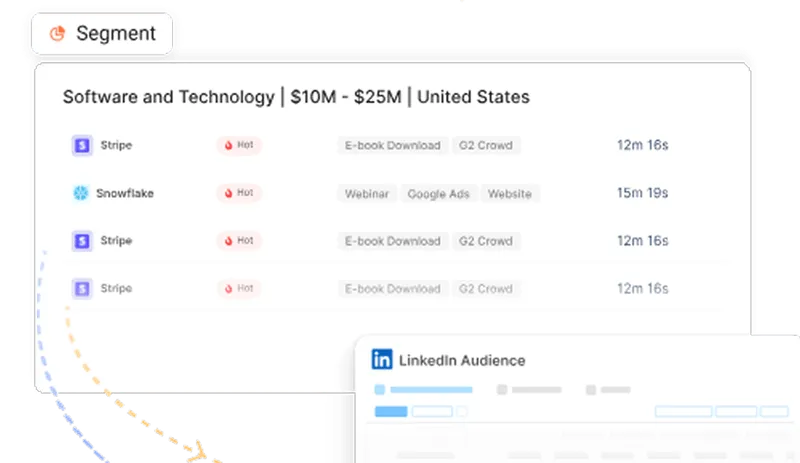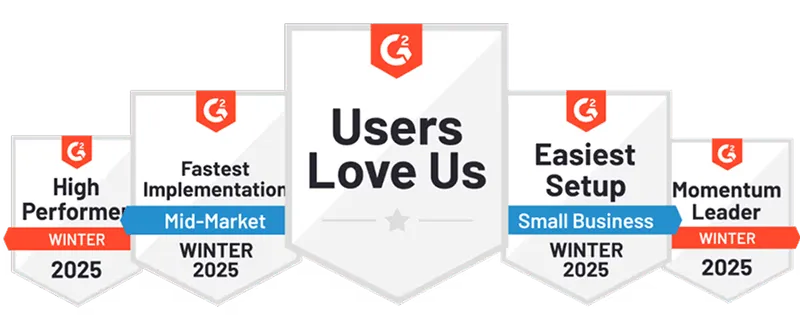7 Warning Signs Your B2B Marketing Strategy Needs a Better Funnel Structure
Learn how to identify and fix common B2B marketing funnel issues. Improve conversion rates, customer retention, and ROI with proven solutions.
Imagine your sales team working hard, but deals stall, leads vanish, and your marketing spend falls short. You're putting in the effort, but the results don't show it. Many B2B companies face this issue when they lack a clear marketing funnel. Without it, prospects slip away, messages get mixed, and your team can't find the problem. The key is to build a funnel that fits the complex B2B buying process. With the right structure, you can guide prospects from first contact to loyal customers, ensuring each stage is set for success.
Let's explore the signs that your strategy might need this vital foundation.
TL;DR
- Low conversion rates at any stage indicate leaks or friction in your funnel, slowing growth and wasting resources.
- High customer loss and poor retention often mean you lack post-purchase engagement or have value gaps.
- Inconsistent brand messaging confuses prospects and erodes trust, making it hard to move leads forward.
- Poor quality traffic and unqualified leads suggest your top-of-funnel activities aren’t reaching the right audience.
- Relying too much on one traffic source risks your funnel if that source dries up.
- Misalignment between marketing and sales teams leads to missed opportunities and a disjointed buyer experience.
- Lack of data-driven decisions and funnel metrics means you’re unable to optimize or prove ROI.
Role of a Funnel Structure in B2B Marketing
A clear funnel structure is essential to effective B2B marketing. B2B buyers take a longer path than B2C buyers, involving more people, facing higher costs, and enduring longer sales cycles. You need a clear process to guide prospects from awareness to decision. Without a structured funnel, you can lose track of where leads drop off or which tactics work.
A proper funnel helps you map each stage: awareness, consideration, decision, and retention, so that you can deliver the right message at the right time. It also aligns your marketing and sales teams, ensuring everyone works toward the same goals. A strong funnel structure turns scattered efforts into a cohesive strategy that boosts conversions and maximizes ROI.
7 Signs Your B2B Marketing Strategy Needs a Proper Funnel Structure
Here are the seven signs that you need a better funnel structure:
Sign 1: Low Conversion Rates Across Funnel Stages
If your B2B marketing funnel has low conversion rates, your strategy might need better structure. When prospects engage with your content but don't move from awareness to consideration, or from consideration to decision, it's time to look closer.
Healthy conversion rates should rise as leads move through the funnel: 1-3% at awareness, 3-5% at interest, and up to 10-15% at action. If your rates are below these numbers, your messaging, targeting, or nurturing tactics might be off.
Without a structured funnel, it's hard to see where leads drop off, making it tough to improve your B2B marketing for better results. Explore how subtle tweaks can lift your sales by visiting our Funnel Conversion Optimization insights.
Sign 2: High Customer Attrition and Poor Retention
High customer attrition and poor retention rates are clear indicators that your B2B marketing strategy lacks a robust funnel structure. When customers leave after their initial purchase, it often indicates a lack of post-purchase engagement or a perceived gap in value.
A well-structured funnel doesn't end at the sale; it includes strategies for nurturing existing customers, encouraging repeat business, and building long-term loyalty. By focusing on customer retention, you can increase lifetime value and reduce the cost of acquiring new customers. Explore how our Account Intelligence feature can help you analyze customer behavior and improve retention.
Sign 3: Inconsistent or Fragmented Brand Messaging
Inconsistent or fragmented brand messaging confuses prospects and erodes trust, making it difficult to move leads forward in the funnel. When your messaging is not aligned across all channels and stages of the funnel, it creates a disjointed experience for potential customers.
A strong funnel ensures that your brand message is consistent and cohesive, reinforcing your value proposition at every touchpoint. This consistency builds trust and helps guide prospects smoothly from awareness to decision.
Sign 4: Poor Quality Traffic and Unqualified Leads
If your B2B marketing efforts bring many visitors but few conversions, you might be attracting poor-quality traffic. High bounce rates, short visits, and leads that don’t fit your ideal customer profile are signs of this issue.
When your funnel lacks structure, your campaigns might target broad or irrelevant audiences, leading to wasted ad spend and low returns. Unqualified leads fill your sales pipeline, making your team spend time on prospects who will never buy.
To fix this, review your targeting criteria, refine your messaging, and use analytics to find which channels and content attract high-value prospects. A well-structured funnel helps you attract and nurture leads that truly fit your business. Explore refined sequenced outreach approaches in Cold Outbound for GTM Efforts to accelerate pipeline growth.
Sign 5: Over-Reliance on a Single Traffic Source
Relying too much on one traffic source, like paid ads, organic search, or one social platform, puts your B2B marketing strategy at risk. If that channel changes its algorithm, raises costs, or restricts your account, your lead flow can drop fast. This lack of variety shows your funnel is not complete.
A strong B2B marketing funnel should bring in and nurture leads from many sources, like SEO, content marketing, email, partnerships, and events. Using just one source often leads to unstable performance and makes it hard to grow. Also, single-source traffic can mislead you about what really drives conversions.
To build strength and steady growth, make sure your funnel captures, nurtures, and converts leads from many channels, not just one. Apply buyer-intent signals to expand your reach with tips from our Intent-Based Outreach resource.
Sign 6: Lack of Alignment Between Marketing and Sales Teams
When marketing and sales teams work separately, your B2B marketing strategy may lack a proper funnel. Marketing might generate leads that sales see as low quality, while sales might not give feedback on what works. This gap can lead to missed chances, mixed messages, and wasted resources.
For example, if marketing focuses on early-stage activities but doesn’t nurture leads enough, sales teams get prospects who aren’t ready to buy. On the other hand, if sales doesn’t share customer feedback, marketing can’t improve its approach.
A structured funnel promotes regular communication, shared goals, and a clear definition of qualified leads. This sales and marketing alignment ensures every funnel stage works together to guide prospects toward conversion and lasting partnerships. To ensure this and to maintain cross-functional momentum, leverage our Workflow Automations.
Sign 7: Absence of Data-Driven Decision Making and Funnel Metrics
A strong B2B funnel relies on clear data at every stage. If your team uses gut feelings or random reports instead of consistent metrics, you miss growth opportunities. Without tracking conversion rates, lead quality, and engagement, you can't find bottlenecks or improve campaigns. This often leads to wasted money, poor strategies, and missed revenue goals.
Modern B2B marketing tools should offer real-time dashboards and analytics to show how prospects move from awareness to purchase. Regularly reviewing these metrics helps you adjust tactics, allocate budget wisely, and show marketing’s value to stakeholders. If you don’t know where leads drop off or which content drives action, your funnel needs a data-driven update to stay competitive and deliver results.
How to Rebuild and Optimize Your B2B Funnel Structure
Here are the steps to rebuild and optimize your B2B funnel structure:
1. Map the Complete Buyer Journey:
Chart each buyer journey stage from initial awareness to post-purchase engagement. Identify where prospects drop off or lose interest.
2. Spot Funnel Gaps and Bottlenecks:
Analyze which funnel stages lack engagement or have low conversion rates. These are your opportunities for improvement.
3. Segment Your Audience Strategically:
Group prospects by firmographics (industry, size, location) and buying roles (decision-maker, influencer, user) for personalized targeting.
4. Align Sales and Marketing Teams:
Define what qualifies as a lead and standardize the lead handoff process to ensure consistent follow-through.
5. Leverage B2B Analytics Tools:
Use platforms like Factors.ai or HubSpot to track funnel performance, monitor drop-offs, and measure key conversion metrics.
6. Test and Optimize Content:
Experiment with new formats (e.g., video, webinars, interactive tools) and platforms (LinkedIn, email, retargeting ads) to boost engagement.
7. Create a Continuous Feedback Loop:
Encourage regular communication between sales, marketing, and customer success teams to refine strategies and improve results over time.
With a clear, data-driven approach, your funnel will attract better leads and build strong customer relationships.
Upgrade Your Funnel Strategy to Drive Better Results
A well-structured funnel is key to successful B2B marketing. Without it, you may face low conversions, high customer turnover, mixed messages, and wasted resources on poor leads. Issues like poor marketing and sales alignment, relying too much on one channel, or lacking useful data can slow your company's growth. Spot these warning signs early to fix your funnel, align your teams, and create a smooth buyer journey.
Effective B2B marketing strategies are not straight paths but flexible and customer-focused, adapting to real buyer actions and needs. Use the right tools, encourage teamwork, and let data guide your choices. This will lead to steady growth and establish your brand as a trusted market leader.
See how Factors can 2x your ROI
Boost your LinkedIn ROI in no time using data-driven insights


See Factors in action.
Schedule a personalized demo or sign up to get started for free
LinkedIn Marketing Partner
GDPR & SOC2 Type II
.svg)









